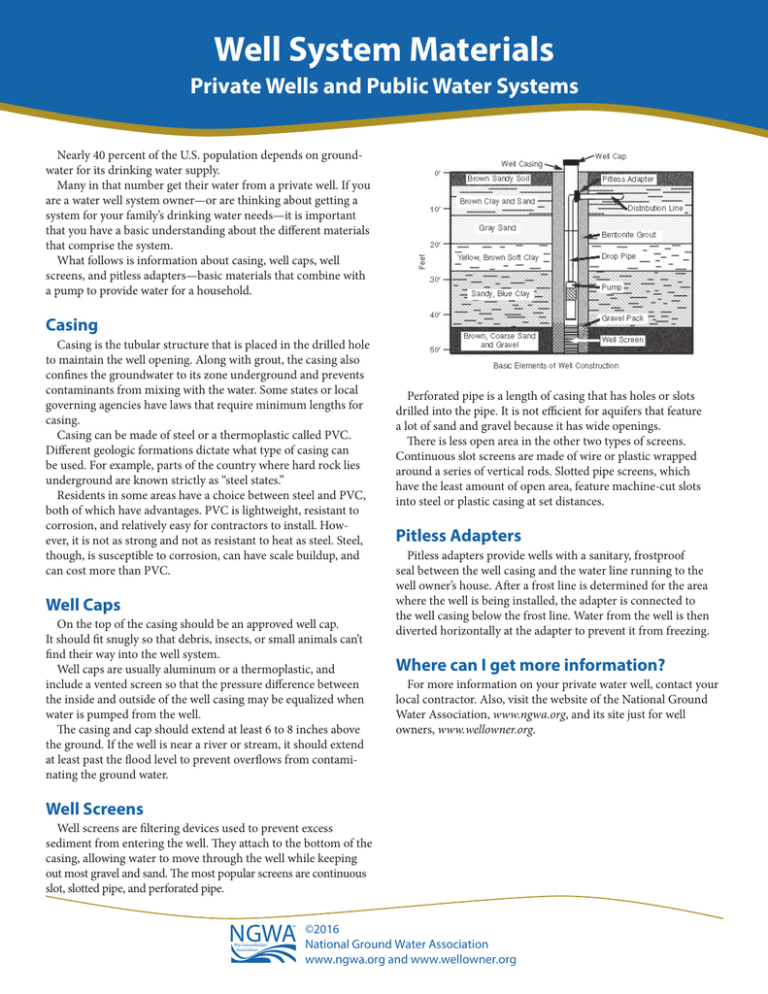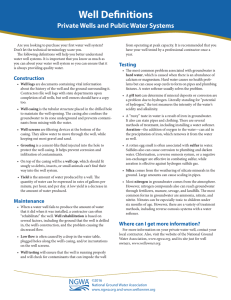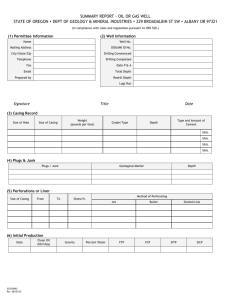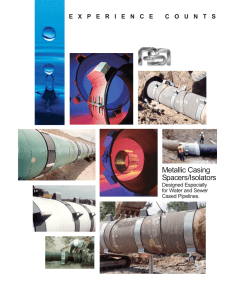Document 11260297
advertisement

Well System Materials Private Wells and Public Water Systems Nearly 40 percent of the U.S. population depends on groundwater for its drinking water supply. Many in that number get their water from a private well. If you are a water well system owner—or are thinking about getting a system for your family’s drinking water needs—it is important that you have a basic understanding about the different materials that comprise the system. What follows is information about casing, well caps, well screens, and pitless adapters—basic materials that combine with a pump to provide water for a household. Casing Casing is the tubular structure that is placed in the drilled hole to maintain the well opening. Along with grout, the casing also confines the groundwater to its zone underground and prevents contaminants from mixing with the water. Some states or local governing agencies have laws that require minimum lengths for casing. Casing can be made of steel or a thermoplastic called PVC. Different geologic formations dictate what type of casing can be used. For example, parts of the country where hard rock lies underground are known strictly as “steel states.” Residents in some areas have a choice between steel and PVC, both of which have advantages. PVC is lightweight, resistant to corrosion, and relatively easy for contractors to install. However, it is not as strong and not as resistant to heat as steel. Steel, though, is susceptible to corrosion, can have scale buildup, and can cost more than PVC. Well Caps On the top of the casing should be an approved well cap. It should fit snugly so that debris, insects, or small animals can’t find their way into the well system. Well caps are usually aluminum or a thermoplastic, and include a vented screen so that the pressure difference between the inside and outside of the well casing may be equalized when water is pumped from the well. The casing and cap should extend at least 6 to 8 inches above the ground. If the well is near a river or stream, it should extend at least past the flood level to prevent overflows from contaminating the ground water. Perforated pipe is a length of casing that has holes or slots drilled into the pipe. It is not efficient for aquifers that feature a lot of sand and gravel because it has wide openings. There is less open area in the other two types of screens. Continuous slot screens are made of wire or plastic wrapped around a series of vertical rods. Slotted pipe screens, which have the least amount of open area, feature machine-cut slots into steel or plastic casing at set distances. Pitless Adapters Pitless adapters provide wells with a sanitary, frostproof seal between the well casing and the water line running to the well owner’s house. After a frost line is determined for the area where the well is being installed, the adapter is connected to the well casing below the frost line. Water from the well is then diverted horizontally at the adapter to prevent it from freezing. Where can I get more information? For more information on your private water well, contact your local contractor. Also, visit the website of the National Ground Water Association, www.ngwa.org, and its site just for well owners, www.wellowner.org. Well Screens Well screens are filtering devices used to prevent excess sediment from entering the well. They attach to the bottom of the casing, allowing water to move through the well while keeping out most gravel and sand. The most popular screens are continuous slot, slotted pipe, and perforated pipe. NGWA SM The Groundwater Association ©2016 National Ground Water Association www.ngwa.org and www.wellowner.org









